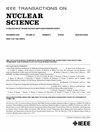Quantification of Neutron-Induced Single-Event Upsets in a Static Random-Access Memory by Clinical High-Energy Photon Beam
IF 1.9
3区 工程技术
Q3 ENGINEERING, ELECTRICAL & ELECTRONIC
引用次数: 0
Abstract
The possibility of using calibrated static random-access memory (SRAM) memory for the quantification of neutron fluence in a radiotherapy facility for cancer treatment utilizing a high-energy 15-MV photon beam (Bremsstrahlung) from an electron linear accelerator has been exploited in this work. This has been performed by varying the field size of the photon beam and the positioning of the SRAM memory at three different positions in relation to the isocenter of the beam. The measurements demonstrated that neutrons originating from interactions between the high-energy photons and accelerator parts with high-Z materials are able to induce single-event upsets (SEUs) in the SRAM memory, where the measured SEUs depend on the measurement location. Monte Carlo (MC) simulations have been performed to retrieve the neutron fluence under each investigated measurement condition. Using the simulated neutron fluence differential in energy and the interactions cross sections determined previously, the expected SEUs were computed. The comparison between measured and simulated SEUs normalized to the linear accelerators (linac) output shows acceptable agreement within the experimental uncertainties. As exposure to secondary neutrons poses a risk to all patients, especially the ones with pacemakers or other electronical aids, the feasibility of establishing the neutron fluence through SEU quantification in an SRAM device provides new opportunities to estimate the associated risk in a clinical environment. Further work can be performed to investigate the correlation between the high-Z linac components and the neutron fluence during patient irradiation to better comprehend the variation between different linac types and manufacturers.通过临床高能光子束量化静态随机存取存储器中由中子诱发的单次事件中断
本研究利用电子直线加速器发出的 15-MV 高能光子束(轫致辐射),在癌症放疗设备中使用校准静态随机存取存储器(SRAM)对中子通量进行量化。测量方法是改变光子束的磁场大小以及 SRAM 存储器相对于光子束等中心的三个不同位置。测量结果表明,来自高能光子和加速器部件与高 Z 材料之间相互作用的中子能够在 SRAM 存储器中诱发单次事件中断(SEU),测量到的 SEU 取决于测量位置。我们进行了蒙特卡罗(MC)模拟,以检索每个调查测量条件下的中子通量。利用模拟的中子能量通量差和先前确定的相互作用截面,计算出预期的 SEU。将测量和模拟的 SEU 与线性加速器(linac)输出归一化后进行比较,结果显示在实验不确定性范围内两者的一致性是可以接受的。由于暴露于二次中子对所有病人,特别是装有心脏起搏器或其他电子辅助设备的病人都构成风险,因此在 SRAM 设备中通过 SEU 量化确定中子通量的可行性为估计临床环境中的相关风险提供了新的机会。还可以开展进一步的工作,研究病人辐照期间高 Z 直列加速器组件与中子通量之间的相关性,以便更好地理解不同直列加速器类型和制造商之间的差异。
本文章由计算机程序翻译,如有差异,请以英文原文为准。
求助全文
约1分钟内获得全文
求助全文
来源期刊

IEEE Transactions on Nuclear Science
工程技术-工程:电子与电气
CiteScore
3.70
自引率
27.80%
发文量
314
审稿时长
6.2 months
期刊介绍:
The IEEE Transactions on Nuclear Science is a publication of the IEEE Nuclear and Plasma Sciences Society. It is viewed as the primary source of technical information in many of the areas it covers. As judged by JCR impact factor, TNS consistently ranks in the top five journals in the category of Nuclear Science & Technology. It has one of the higher immediacy indices, indicating that the information it publishes is viewed as timely, and has a relatively long citation half-life, indicating that the published information also is viewed as valuable for a number of years.
The IEEE Transactions on Nuclear Science is published bimonthly. Its scope includes all aspects of the theory and application of nuclear science and engineering. It focuses on instrumentation for the detection and measurement of ionizing radiation; particle accelerators and their controls; nuclear medicine and its application; effects of radiation on materials, components, and systems; reactor instrumentation and controls; and measurement of radiation in space.
 求助内容:
求助内容: 应助结果提醒方式:
应助结果提醒方式:


